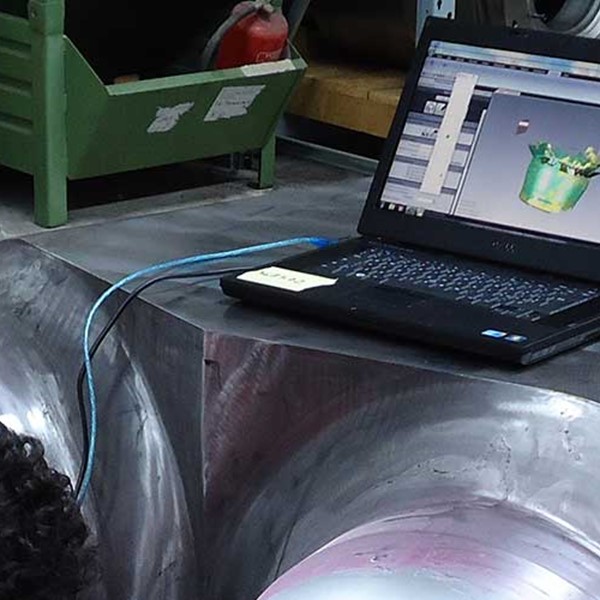

Barred Tee Fittings: Everything You Need To Know
Barred tee fittings are essential to guarantee a safe and efficient management of fluid flows in pipeline systems. On this page, we will delve into their specifications and role in pipelines while discovering the whole M.E.G.A. range and why you should opt for our products.

When we talk about barred tee fittings, we refer to a specialize component primarily used in pipeline systems to guarantee uninterrupted flow of liquid or gas, even when branch lines are present.
On this page, we will discuss:
- What are barred tees?
- What are the main barred tee fitting specifications?
- What is the difference between tee and barred tee?
- Materials
- Industrial applications of barred tees
- Why is it so important to opt for barred tee for pipelines?
- M.E.G.A. is a trustworthy barred tee fittings manufacturer
- FAQ
What are barred tee fittings?
A barred tee is a type of pipeline fitting with a branch connection used in pigged systems, designed to prevent the passage of pigs into the branch line. It features restriction bars welded internally across the branch opening. These bars are precisely aligned with the internal diameter of the main pipeline, ensuring a smooth and unobstructed passage of the pig during operation.
The bars are manufactured from the same or equivalent material as the parent pipe, guaranteeing consistent mechanical and corrosion-resistant properties. They are positioned on the internal side of the tee—or on any branch connection sufficiently large to allow a pig to deviate—to guide the pig through the main run of the pipeline.
Each bar is dimensioned to ensure minimal flow interference while providing the necessary structural strength to withstand the flow-induced stresses within the branch. This careful balance between hydraulic performance and mechanical integrity makes barred tees an essential component in pipeline systems for oil and gas, petrochemical, and subsea applications.
Each component is produced according to international standards (e.g., ASME B31.3, ASME BPV Code, EN 13480) and validated through Finite Element Analysis (FEA) to ensure structural integrity and durability under high-pressure and high-temperature conditions.
What Are The Main Barred Tee Fitting Specifications?
Barred tee fittings, also known as branch outlet fittings, usually perform a 90-degree angle connection as it is characterized by a series of transverse bars that extend internally from one side of the tee to the other. These bars are located at the junction between the main line and the branch to block the passage of solid particle or debris that could compromise the fluidity of the flow and the correct functioning of valves and other system components.
Main barred tee fitting technical specifications encompass:
- The materials used to engineer it, such as carbon steel, stainless steel, duplex and super duplex stainless steel, nickel alloys, copper alloys, titanium and so forth. All these metals are corrosion-resistant to ensure the utmost durability and compatible with the type of fluid transported.
- The fitting dimensions must fit those of the pipelines to which it is connected.
- Their resistance in high pressure and temperature applications.
- The utmost safety and quality according to the American Petroleum Institute (API) or other international standardization bodies, such as ISO and ASME.
Ultimately, a barred tee fitting is a core factor in ensuring and maintaining the operational integrity and effectiveness of the entire piping system.
What is the difference between tee and barred tee?
| Parameter | Standard Tee | Barred Tee |
|---|---|---|
| Definition | A standard pipe fitting used to create a 90° branch connection between three sections of pipe. | A specialized tee designed for pigged pipeline systems, equipped with internal restriction bars to prevent the pig from entering the branch line. |
| Manufacturing Process | Typically forged or extruded, following standard geometries and dimensions defined by international norms. | Usually custom-fabricated, with bars welded internally to the branch section according to project-specific requirements. |
| Application | Commonly used in general piping and process systems for fluid distribution or mixing. | Primarily employed in pipeline engineering, especially near pig launchers, receivers, or manifolds to ensure uninterrupted pig passage. |
| Applicable Design Codes / Standards | ASME B16.9, MSS SP-75, and equivalent international specifications. | Shell DEP 31.40.10.13-Gen, ISO 15590-2, and project-specific subsea or offshore standards. |
| Production Volume | Manufactured in large batches for standard use in multiple industries. | Produced in limited or custom quantities, tailored to specific pipeline configurations. |
| Cost | Lower cost due to standardized mass production. | Higher cost resulting from bespoke design, fabrication, and inspection requirements. |
Materials
M.E.G.A. manufactures barred tees using a wide range of materials to meet the most demanding operating conditions in terms of pressure, temperature, and corrosion resistance. All materials are carefully selected to guarantee mechanical strength, durability, and compatibility with customer specifications.
- Carbon Steels – Standard grades used in general pipeline applications, offering good weldability and cost efficiency.
- Low-Temperature Carbon Steels – Suitable for cryogenic or sub-zero service conditions, providing excellent toughness and resistance to brittle fracture.
- High-Yield Steels – Designed for applications requiring high mechanical strength and reduced wall thickness while maintaining structural integrity.
- Chrome-Moly Alloy Steels – Ideal for high-temperature and high-pressure service conditions such as refineries, petrochemical plants, and power generation facilities.
- Stainless Steels – Available in multiple grades (e.g., 304, 316) for superior corrosion resistance and longevity in standard process environments.
- Duplex and Super Duplex Steels – Combining high yield strength with exceptional resistance to pitting, crevice, and stress corrosion cracking, these alloys are widely used in offshore and subsea installations.
- SMO F44 – A high-alloy austenitic stainless steel offering exceptional corrosion resistance in chloride-rich and seawater environments.
- Nickel Alloys – Including grades such as Inconel® and Monel®, used in extreme service conditions involving high temperature, pressure, or highly corrosive fluids.
- Other Special Grades – Available upon request and fully engineered according to customer specifications and project requirements.
Industrial applications of barred tees
Barred tees are primarily installed in piggable pipeline systems, where internal inspection or cleaning tools (pigs) must travel along the main run without deviating into branch lines. These fittings are essential in guaranteeing safe and uninterrupted pig passage, preventing tool damage or operational downtime.
Typical applications include:
- Oil & Gas pipelines – Onshore and offshore systems where barred tees are installed near pig launchers, receivers, and manifolds to prevent pig blockage or deviation.
- Petrochemical and refinery systems – Where debris or solid particles are present and branch protection is crucial to maintain process flow.
- LNG, hydrogen, and chemical processing facilities – Where internal cleaning, inspection, and high-integrity performance are mandatory for system reliability.
- Power generation plants – Especially in high-pressure and high-temperature loops, where robust fittings ensure long-term performance.
- Subsea and offshore installations – Where accessibility is limited, and corrosion-resistant, high-strength materials are required for long service life.
Each barred tee manufactured by M.E.G.A. is designed according to applicable international standards (ASME B31.3, ASME BPV Code, EN 13480, ISO 15590-2) and validated through Finite Element Analysis (FEA) to ensure mechanical integrity and hydraulic efficiency.
Why Is It So Important To Opt For Barred Tee For Pipelines?
The installation of a barred tee fitting is vital for the efficiency and maintenance of your pipeline system.
Here, we explain why you should make this decision.
First, these fittings are specifically engineered to prevent particles from entering branch lines, blockages, troubleshooting and any kind of disruption. In fact, there are certain pipelines for the Oil & Gas industry that transport fluids with suspended solids. Such application is more subjected to clogging and sedimentation. Barred tee fittings can be extremely effective in filtering fluids and allowing an unimpeded passage.
Another important factor to consider is the reinforcing action of barred tee fittings to the whole pipeline structure where junctions are located. These connections are often vulnerable to high pressure and mechanical stress and, thanks to this component, they avoid failures and leaks that pose severe environmental and safety risks.
As a result, the maintenance operations of the pipeline are easier as well as inspection routines, as the main flow can be temporarily diverting without blocking the whole system, minimizing operational downtime, boosting productivity while keeping an eye on safety and performance.
Are you interested in our barred tee fitting?
M.E.G.A. Is a Trustworthy Barred Tee Manufacturer
At M.E.G.A., we deeply value trust and transparency. As a leading barred tee manufacturer, we have earned a reputation on a national and international level for the durability and quality of our products.
Every piece can be customized and is crafted paying attention to each detail. We are always searching for an innovative approach that can combine functionality and safety - proving our accuracy in engineering secure and reliable fittings for every piping system.
The dedication and passion in what we do is reflected in our adherence to strict quality control in-house processes, as well as in the implementation of groundbreaking technologies in our manufacturing practices.
Frequently Asked Questions (FAQ)
- What is a barred tee fitting?
A barred tee is a type of pipe fitting designed for piggable pipelines. It features internal restriction bars welded across the branch outlet to prevent pipeline pigs or inspection tools from entering the branch and ensure smooth passage through the main run.
- When is a barred tee required?
Barred tees are required in piggable pipelines, typically near pig launchers and receivers, or wherever the pipeline design includes branches that could divert a pig. They are widely used in oil & gas, subsea, and chemical processing facilities.
- How are barred tees manufactured and what standards apply?
Unlike standard tees (produced by extrusion or forging according to ASME B16.9 or MSS SP-75), barred tees are generally fabricated. They are made by welding restriction bars onto a standard tee or custom-machined fitting. Common design references include Shell DEP 31.40.10.13-Gen and ISO 15590-2.
- Do the internal bars restrict flow?
The bars are designed to be flush with the inner diameter of the pipeline, ensuring pigs can pass freely without hanging up. The spacing and bar dimensions are calculated to minimize pressure drop while preventing the pig from entering the branch.
- Are barred tees more expensive than standard tees?
Yes. Because barred tees are custom-engineered and fabricated, produced in smaller quantities, and often made from special materials, their cost is higher than that of standard tees manufactured in bulk by forging or extrusion.
Choose M.E.G.A. for your next barred tee fitting project

